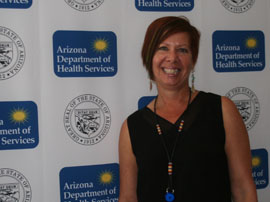Cronkite News has moved to a new home at cronkitenews.azpbs.org. Use this site to search archives from 2011 to May 2015. You can search the new site for current stories.
Officials: Spring means spike in bicycle injuries for Arizona children
PHOENIX – For many Arizona children, spring means it’s time to dust off bicycles and pedal about their neighborhoods.
For Susan Bookspan, an injury-prevention specialist at Phoenix Children’s Hospital, it means more young bicyclists coming in with injuries ranging from scrapes to internal injuries caused by ramming into handlebars.
“Of course, the worst are head injuries,” Bookspan said. “Those little bumps and big bumps do add up.”
Reports by the Arizona Department of Health Services and city of Phoenix suggest that bicycle injuries involving children peak in March and April and remain high through May.
In 2010, two Arizona children died as a result of bicycle collisions, and neither was wearing a helmet, according to the state’s 2011 Child Fatality Program report.
Tomi St. Mars, the office chief for injury prevention at the Arizona Department of Health Services, urged parents to be especially careful when supervising their young bicyclists during these months.
“Being active is important, but you need to be safe at the same time,” she said.
Bookspan and others say helmets are the first step to preventing serious bicycle injury.
“Helmets have been shown to prevent head injuries 85 percent of the time and brain injuries 88 percent of the time,” Bookspan said. “That statistic is … better than wearing a seatbelt in a car.”
In 2007, when Phoenix prepared its Bicycle Collision Summary, the city recorded 106 bicycle accidents involving children. Of the 46 cases for which it received information on helmet use, only four of the injured children had worn helmets.
Among consumer products, only automobiles are linked to more injuries among children nationally than bicycles, according to the nonprofit group Safe Kids Worldwide. An average of 630 children under the age of 14 are involved in cycle-related crashes every day in the U.S., the group reported, and only about 45 percent of those children wear helmets.
Lindsay Hansen, recreational safety program manager for Safe Kids Worldwide, said children who crash and aren’t wearing helmets are more likely to suffer some type of brain injury, including concussions in more serious accidents.
“This is not just about saving yourself from cuts and bruises; it’s about saving your future,” she said. “Brain injuries can affect the way you think, speak, what you do and how you move.”
Other safety tips include making sure a bike works properly, recognizing and following traffic signs and signals and knowing how to brake safely.
The Safe Kids Coalition of Maricopa County, an affiliate of Safe Kids Worldwide, offers bicycle rodeos to show kids how to ride safely, including navigating an obstacle course and a four-way stop, as well as how helmets should fit.
“Bicycle rodeos teach children skills that translate to life in general,” said Jean DeStories, transportation safety educator for the city of Mesa. “It teaches children to be aware, to think quickly, and how to lead an active lifestyle.”
The Safe Kids Coalition of Maricopa County collaborated with Phoenix Children’s Hospital on a program called Helmet Your Brain – Avoid the Pain, which offers bicycle safety materials to schools.
Parents shouldn’t wait for schools or bicycle rodeos to teach their children about bicycle safety, however. According to Bookspan of Phoenix Children’s Hospital, parents are the No. 1 role models for kids learning to ride.
“Kids are more than triple likely to wear helmets when their parents wear helmets,” she said. “If it’s something you teach from an early age, it’s just something the child will do.”







